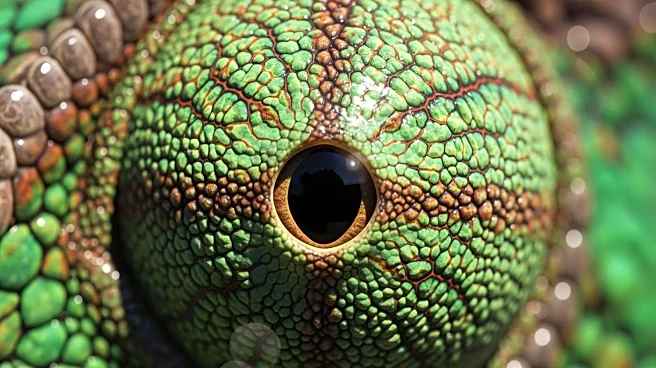What's Happening?
Scientists have finally solved the mystery of chameleons' independently moving eyes, a subject of fascination since ancient Greece. Modern imaging technology has revealed that chameleons possess two long,
spiraled optic nerves behind each eye, a feature unique among lizards. This discovery was made by Juan Daza, an associate professor at Sam Houston State University, and Edward Stanley, director of the Florida Museum of Natural History's digital imaging laboratory. The optic nerves allow chameleons to move their eyes independently, scanning their environment for prey, and then coordinate their gaze to target their tongues accurately. The study utilized CT scanning technology, which provided detailed images without damaging the specimens, allowing researchers to confirm the presence of these coiled optic nerves across multiple chameleon species.
Why It's Important?
The discovery of the chameleons' unique optic nerve structure is significant as it provides insight into the evolutionary adaptations of these reptiles. Chameleons have evolved to maximize their field of vision without the need for neck mobility, a trait that is crucial for their survival in tree-dwelling environments. This adaptation allows them to efficiently hunt prey with their powerful tongues. The research highlights the importance of modern imaging techniques in uncovering anatomical features that were previously hidden, offering new perspectives on vertebrate evolution. The findings could inspire further studies into similar adaptations in other species, potentially leading to broader understanding of evolutionary biology.
What's Next?
Researchers plan to investigate whether other tree-dwelling lizards have developed similar optic nerve adaptations. The study opens avenues for exploring the evolutionary timeline of chameleons and understanding the development of their specialized traits. The use of CT scanning and open data initiatives like oVert will continue to play a crucial role in future research, allowing scientists to explore anatomical structures without damaging specimens. This could lead to new discoveries in the field of vertebrate anatomy and evolution.
Beyond the Headlines
The discovery challenges historical theories proposed by figures like Aristotle and Isaac Newton, who speculated on the chameleons' eye movements without understanding the underlying anatomy. The research underscores the importance of revisiting historical scientific assumptions with modern technology, which can lead to groundbreaking insights. The study also highlights the role of interdisciplinary collaboration, as language experts were involved to decipher historical texts, demonstrating the value of diverse expertise in scientific research.














